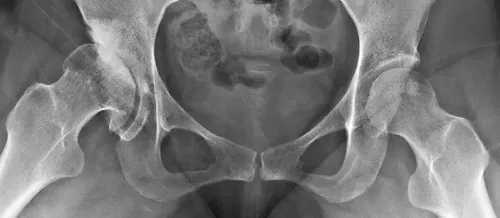Child's hip dysplasia
"Proper selection of patients for non-arthroplastic surgical alternatives can improve their prognosis possibly by reducing or delaying degenerative changes".
DR. JORGE GÓMEZ
SPECIALIST. ORTHOPEDIC SURGERY AND TRAUMATOLOGY DEPARTMENT

Hip dysplasia, formerly called congenital dislocation of the hip, is an abnormal development of the joint between the thigh bone (femur) and the hip, which causes a shift away from the femur (when it comes out completely it is called dislocation).
It occurs before birth, during birth, or even shortly after birth.
There are some circumstances that increase the chances of suffering from it, such as: history of hip dysplasia in parents or siblings, maternal high blood pressure during pregnancy, lack of amniotic fluid during pregnancy, prolonged pregnancy, multiple pregnancy, cesarean delivery, breech delivery, very large or very small newborns, and others.

What are the symptoms of hip dysplasia in the child?
They are variable, depending on when it occurs, the degree of displacement of the femur outside the hip and the age of the child.
From birth until the child begins to walk usually does not produce symptoms, should be suspected and detected by the pediatrician when exploring it.
Later it produces a delay in the age to which the child begins to walk, with a limp or duck walk. It does not usually cause pain until after the age of five.
The most common symptoms are:
- Lameness when you start to walk.
- Pain in the hip, if it is allowed to evolve.
Does your child have any of these symptoms?
You may have hip dysplasia
How is a child diagnosed with hip dysplasia?

Hip dysplasia in the child appears in approximately three out of every thousand newborns, most often affecting girls (they account for 8 out of every 10 cases) and the left hip.
From the first examination of newborns in the delivery room, and in subsequent well-baby visits, the pediatrician will carefully explore the shape and mobility of the child's hips to detect any signs of instability or displacement.
In this case, an ultrasound scan of the hips (useful from birth to 3-4 months of age) or a hip x-ray (from 4 months of age) will be performed to observe the joint in detail.
How is a child's hip dysplasia treated?
The sooner it is diagnosed and the sooner treatment begins, the better the outcome.
It depends on the severity of the displacement and the age at which it is diagnosed
The aim is to get the femur correctly repositioned in the hip and keep it that way.
From birth to 6 months of age, this is achieved by placing the child in a harness or strap system that must be worn constantly over his clothes, for several weeks or months (usually 2-4 months), until the stability of the hip is checked. With this treatment and in children under 6 months, healing is achieved in 90% of cases.
If the hip dysplasia is diagnosed once the child has started crawling (beyond 6 months) or the use of the sling has not been effective, the treatment is much more complex and cumbersome, requiring continuous traction of the thigh for several weeks with a bulky pulley system, followed by a surgical operation (reduction or repositioning of the joint). Subsequently, to stabilize it, the hip is plastered for several months.
Where do we treat it?
IN NAVARRE AND MADRID
The Department of Orthopedic Surgery and Traumatology
of the Clínica Universidad de Navarra
The Department of Orthopedic Surgery and Traumatology covers the full spectrum of congenital or acquired conditions of the musculoskeletal system including trauma and its aftermath.
Since 1986, the Clinica Universidad de Navarra has had an excellent bank of osteotendinous tissue for bone grafting and offers the best therapeutic alternatives.
Organized in care units
- Hip and knee.
- Spine.
- Upper extremity.
- Pediatric orthopedics.
- Ankle and foot.
- Musculoskeletal tumors.

Why at the Clinica?
- Experts in arthroscopic surgery.
- Highly qualified professionals who perform pioneering techniques to solve traumatological injuries.
- One of the centers with the most experience in bone tumors.




















